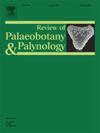A gondwanan Jurassic bryoflora? Anatomically preserved bryophytes in geothermal paleoenvironments from the Jurassic of Patagonia, Argentina
IF 1.7
3区 地球科学
Q2 PALEONTOLOGY
引用次数: 0
Abstract
The Deseado Massif, which is located in the western part of the Santa Cruz Province, Argentina, contains numerous hot spring deposits related to the final stages of the Bahía Laura Complex. The aim of this study is to analyze the first Jurassic deposits with permineralized bryophytes at La Bajada hot spring-related locality, expanding the diversity of Jurassic bryophytes with anatomical preservation. > 200 fossiliferous petrographic thin sections were examined, leading to the discovery of four bryophyte morphotypes of leafy and thallose gametophytes. Detailed comparisons between each morphotype and extant and extinct bryophytes were carried out. The morphotypes described here may have various phylogenetic affinities, based on the latest comprehensive phylogenetic analyses of extant bryophytes. Although morphotypes described here do not represent the oldest representative for the lineages they represent, each of the studied fossils has a consistent set of diagnostic characters that relates them to specific nodes within bryophyte phylogeny. Moreover, the affinities of morphotype A with Marchantiales and Neohodgsoniales suggest affinities with the clade that is composed of these two orders together with Sphaerocarpales. Affinities of morphotypes B, C and D are more ample and related to different orders including within Bryophyta sensu stricto.
冈瓦纳侏罗纪苔藓菌群?阿根廷巴塔哥尼亚侏罗纪地热古环境中解剖保存的苔藓植物
Deseado地块位于阿根廷圣克鲁斯省西部,包含许多温泉矿床,这些温泉与Bahía劳拉复合体的最后阶段有关。本研究的目的是在La Bajada温泉相关地区首次分析侏罗纪苔藓植物过矿化沉积,以解剖保存的方式扩大侏罗纪苔藓植物的多样性。比;研究了200个化石岩石薄片,发现了四种苔藓植物的叶状配子体和thallose配子体形态。对各种形态、现存和灭绝的苔藓植物进行了详细的比较。根据对现存苔藓植物的最新综合系统发育分析,这里描述的形态类型可能具有不同的系统发育亲缘关系。尽管这里描述的形态类型并不代表它们所代表的谱系中最古老的代表,但所研究的每一个化石都有一组一致的诊断特征,这些特征将它们与苔藓植物系统发育中的特定节点联系起来。此外,形态型A与Marchantiales和Neohodgsoniales的亲缘关系表明它与由这两个目和Sphaerocarpales组成的进化支有亲缘关系。B、C、D三种形态型的亲缘关系较为丰富,属于不同目,包括在狭义苔藓植物中。
本文章由计算机程序翻译,如有差异,请以英文原文为准。
求助全文
约1分钟内获得全文
求助全文
来源期刊
CiteScore
3.50
自引率
21.10%
发文量
149
审稿时长
6 months
期刊介绍:
The Review of Palaeobotany and Palynology is an international journal for articles in all fields of palaeobotany and palynology dealing with all groups, ranging from marine palynomorphs to higher land plants. Original contributions and comprehensive review papers should appeal to an international audience. Typical topics include but are not restricted to systematics, evolution, palaeobiology, palaeoecology, biostratigraphy, biochronology, palaeoclimatology, paleogeography, taphonomy, palaeoenvironmental reconstructions, vegetation history, and practical applications of palaeobotany and palynology, e.g. in coal and petroleum geology and archaeology. The journal especially encourages the publication of articles in which palaeobotany and palynology are applied for solving fundamental geological and biological problems as well as innovative and interdisciplinary approaches.

 求助内容:
求助内容: 应助结果提醒方式:
应助结果提醒方式:


